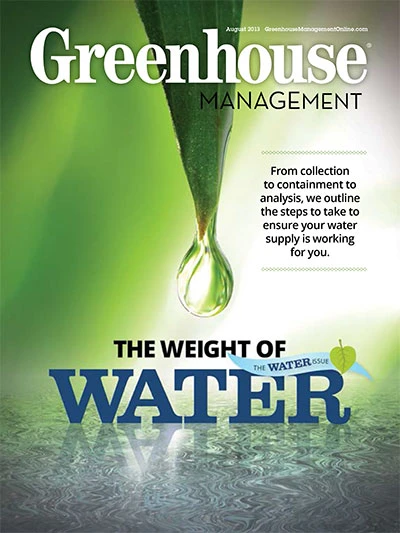.jpg) Julie Newman Julie Newman |
Water quality management plans typically include a site map, a checklist of current management practices to mitigate runoff and groundwater leaching, and a list of practices that will be implemented in the future with a timeline for implementation. Developing a water quality management plan is a good idea even if you are in an area where such plans are voluntary. First, the planning process will help you determine if any problems exist that contribute to water pollution. Second, a water quality management plan may be used to complete documents required by regulatory agencies. Following are some tips that can be used to develop your plan. Know the regulations. Make it a priority to know what water quality regulations affect greenhouse growers in your area. Many states rely on federal regulations of the Clean Water Act (CWA) and voluntary compliance. CWA requires each state to make a list of impaired streams, lakes, estuaries or other water bodies and develop total maximum daily loads (TMDLs) for each pollutant causing the impairment. Be aware of any impaired water bodies that may be impacted by discharges from your operation; be an active stakeholder in the development of any TMDLs for these water bodies. There may be local agencies that administer the CWA and other water quality regulations in your area. Obtain a copy of the agency’s water quality plan to determine the local water quality objectives.
Know what’s in your runoff. Inventory chemicals used in your operation, especially those likely to be present in runoff. Know the basic properties of the pesticides used at your operation and how they may impact local water. Monitor runoff flow and basic nutrient concentrations in discharges. It is also recommended that you test for other contaminants according to the products used. Compare results of your water analyses against local, state and federal water quality standards and regulations for potential noncompliance issues. Establish and maintain water quality runoff records and use them for planning future improvements. Compile a list of management practices. A management practice is a specific practice for accomplishing a management goal. For example, “Base decisions to use pesticides and other control options on monitoring information.” Management practices are usually called best management practices (BMPs), but the “best” practices vary with on-site specifications. Lists of BMPs are available that can be employed to protect water quality. Check with your Natural Resources Conservation Service (USDA NRCS) or your Cooperative Extension office. A checklist of practices specific for greenhouses and nurseries is available at http://ceventura.ucdavis.edu/files/153137.pdf. Conduct a water quality audit. A water quality audit is a way to evaluate current management practices that may impact water quality. It can be conducted by going through your compiled list of BMPs and checking off the ones that you have already implemented. This exercise will increase your awareness of the variety of practices to mitigate runoff and leaching and provide an easy way to identify areas that require improvements. Develop and implement the plan. After the audit, go back through the list and highlight the BMPs applicable to your operation that you have not implemented. Select BMPs from those highlighted which would help you meet your plan objectives. Which BMPs you select depends on economics and specific conditions unique to your operation. The easiest and least costly BMPs to implement are often practices that reduce the quantity of runoff and pollutant loads, but may still need to adopt practices that treat and contain runoff. Once you determine which BMPs you plan to implement, the final step is to develop a schedule for implementation. This may require a financial analysis to determine when any needed capital would be available for construction, materials or labor. If you need financial assistance, funding for BMP implementation may be available from various sources such as the NRCS.
Julie Newman is an environmental horticulture advisor at the University of California Cooperative Extension. Have a question? You can write Julie at jpnewman@ucdavis.edu. |
Get curated news on YOUR industry.
Enter your email to receive our newsletters.
Explore the August 2013 Issue
Check out more from this issue and find your next story to read.
Latest from Greenhouse Management
- Society of American Florists accepting entries for 2025 Marketer of the Year Contest
- Sustainabloom launches Wholesale Nickel Program to support floriculture sustainability
- American Horticultural Society welcomes five new board members
- Color Orchids acquires Floricultura Pacific, becoming largest orchid supplier in U.S.
- American Floral Endowment establishes Demaree Family Floriculture Advancement Fund
- The Growth Industry Episode 3: Across the Pond with Neville Stein
- Flowerful growth
- The Growth Industry Episode 2: Emily Showalter on how Willoway Nurseries transformed its business







